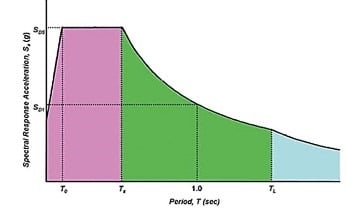Factors Affecting Degree of Earthquake Damages to Buildings
Various factors such as brittle columns, stiffness elements, flexible ground floor, short columns, shapes, sizes, number of storeys, type of foundation, location of adjacent buildings, structural layouts etc. affects the degree of damages to buildings during earthquakes.
These factors which influence the degree of damages that a structure experience during earthquake are discussed.

Fig.1: Failure of Buildings Due to Earthquakes
Factors Affecting Degree of Earthquake Damages to Buildings
The factors that affect the extent of earthquake damages to the structures include:
- Deviation between design and actual response spectrum
- Brittle columns
- Asymmetric arrangement of stiffness element in plan
- Flexible ground floor
- Short columns
- Shape of the floor plan
- Shape of the building in elevation
- Slabs supported by columns without beams
- Damages due to previous earthquake
- Reinforced concrete building with a frame structural system
- Number of storeys
- Type of foundation
- Location of adjacent buildings in the block
- Slab levels of adjacent structure
- Poor structural layout
Deviation Between Design and Actual Response Spectrum
Improper evaluation of anticipated earthquake characteristics used in the earthquake design of the structure is the most common and critical factors for the damage of buildings. However, this is not the only factor since there are certain features of the structure that could be seismic weak point.

Fig.2: Design Response Spectrum
Brittle Columns
It is reported that, the majority of structures failed during earthquake are due to column failure. The column may fail due to deterioration of concrete as a result of cyclic loading and insufficient number of ties embedded in the column at the critical locations.

Fig.3: Brittle Failure of Column
Asymmetric Arrangement of Stiffness Element in Plan
Cores in structures are the basic stiffness element and its location with regard to the building would influence the behavior of the structure during earthquakes and eventually affect the extent of the damage. However, it is reported that, small percentage of failed buildings was due to eccentricities of the core of staircase and elevators.
Flexible Ground Floor
Flexible ground floor is another factor that contributes to the damage that structure may encounter during earthquake.
When stiffness is abruptly reduced at specific level of a structure, then stresses on the structural elements of flexible story would increase and subsequently fail. Therefore, the presence of soft story would increase the extent of structural seismic failure
Flexible ground floor is made when this floor is used for commercial purposes and broad spaces need to be provided.

Fig.4: Flexible ground floor of multi storey structure which could cause structural failure during earthquake

Fig.5: Soft storey problem during earthquake
Short Columns
The failure of short columns due to earthquakes is less common compare ordinary column failure. However, short column may fail in shear in explosive manner and eventually lead to the collapse of the structure.

Fig.6: Short Column in a Building
Shape of floor plan
It is demonstrated that, square shape floor plan exhibit the best seismic behavior compare with other shapes such as X, I, and +. Therefore, the extent of building seismic damage is influenced by floor shape plan.
Shape of Building in Elevation
It is proven that, structures with regular upper storeys show superior seismic response compared with buildings which their upper storeys are in form of setbacks.
Slabs Carried by Columns Without Beams
Flat slab system is considerably vulnerable structural system and does not have satisfactory resistance against seismic effects. Such structural system is considerably flexible and has low ductility.
That is why EC8 prevents the use of flat slabs unless other seismic resistant structures like shear walls and flexible frames are used as well.

Fig.7: Flat slab system
Damages of Structures due to Previous Earthquakes
Building that suffered certain type of damages from previous earthquakes would experience the same mode of failure if the repair technique had not been conducted properly.
It is found that, structures that repaired long time ago would undergo the same damage but this is less common in most recent repaired structures. This is because repairing methods have developed and hence their effects are more profound.
Reinforced Concrete Buildings with Frame Structural System
Frame structural system is the source of vulnerability is buildings. This is because it undergoes considerable inter-storey drift during seismic excitation. Such large displacement damage infill walls that their repair is substantially costly.
So, the major point that makes frame structural system vulnerable is the high cost needed to repair damaged infill walls.
Number of Storeys
It is reported based on statistical data that, the vulnerability of structure to earthquake forces decreases as the number of storeys are increased.
It shown in several earthquakes like those of Bucharest in 1997 and Mexico City that the extent of damages was more severe in high rise building (more than three storeys) compare with low rise buildings.
It is known that, the presence of masonry infill in building will not only increase the strength of the structure but also it improves its stiffness. These improvements are more obvious and effective in low rise buildings compare with high rise structures.
Type of Foundation
Type of foundation used influence the degree of earthquake damages in two forms including direct and indirect effect.
With regard to direct effect of foundation form, it manifest itself in number of characteristics such as fracture of foundation soil, failure of foundation member like foundation beam fracture, ground differential settlement which is the most common effect , soil liquefaction that is rarely occur but has catastrophic effect, and general or partial landslide of foundation soil.
The indirect influences of foundation type include out of plane movements of individual columns base in the case of isolated foundations which are not connected together, or when beams between foundations are flexible.
Therefore, isolated foundation would increase the severity of the earthquake damages.
Location of Adjacent Buildings in the Block
The location of the adjacent buildings on the block affects seismic response of the structure considerably. For example, buildings at the corner of the block would experience greater damage and more sensitive to earthquakes compare with free standing structures.
Factors such as asymmetric distribution of stiffness in building plan and transfer of kinetic energy through poundings are commonly increase the vulnerability of the corner buildings.
Slab Levels of Adjacent Structures
It is found that, the impulse loading that a structure gets from adjacent buildings have a considerable influence on the extent of the earthquake damages. It is reported that, the extent of damages in structures with different floor level slabs are significantly greater than buildings with the same floor slab level.
This can be clearly observed in Mexico City earthquake which occurred in 1985 and Thessaloniki earthquake occurred in 1978.
Poor Structural Layout
By and large, poor collaboration between architectural engineer and structural engineer at conceptual design phase results in poor structural layout.
Examples of poor structural layout includes cut off of columns, asymmetric arrangements of stiffness elements in plan and elevation, and irregularities in form in plan and elevation.
It is reported that around one third of structures collapsed in Athen earthquake occurred in 1999 were due to poor structural layout.
No comments:
Post a Comment